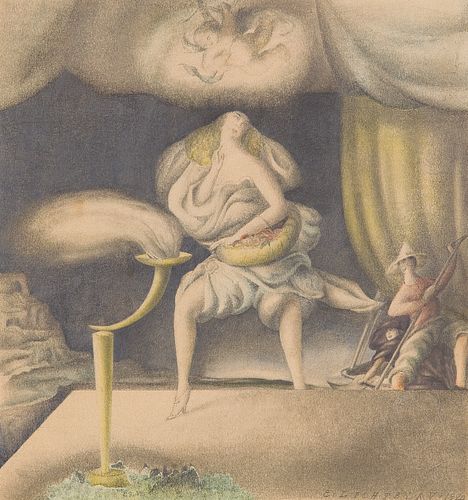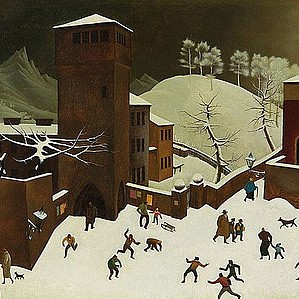ERNST LICHTBLAU (Vienna 1883 - 1963 Vienna) Dancer, 1920
Lot 69
Categories
Estimate:
EUR€1,000 - EUR€2,000
$1,075.27 - $2,150.54
Absentee vs Live bid
Two ways to bid:
- Leave a max absentee bid and the platform will bid on your behalf up to your maximum bid during the live auction.
- Bid live during the auction and your bids will be submitted real-time to the auctioneer.
Bid Increments
| Price | Bid Increment |
|---|---|
| EUR€0 | EUR€10 |
| EUR€100 | EUR€50 |
| EUR€700 | EUR€100 |
| EUR€1,000 | EUR€200 |
| EUR€3,000 | EUR€300 |
| EUR€3,600 | EUR€400 |
| EUR€4,000 | EUR€500 |
| EUR€7,000 | EUR€1,000 |
| EUR€16,000 | EUR€2,000 |
| EUR€30,000 | EUR€3,000 |
| EUR€36,000 | EUR€4,000 |
| EUR€40,000 | EUR€5,000 |
About Auction
By Widder Auctions
May 19, 2022
Set Reminder
2022-05-19 11:00:00
2022-05-19 11:00:00
America/New_York
Bidsquare
Bidsquare : Masterpieces
https://www.bidsquare.com/auctions/widder-auctions/masterpieces-9287
Masterpieces of classical modernism by Austrian and international artists coming up for auction in Vienna on May 19th Widder Auctions office@widderauktionen.com
Masterpieces of classical modernism by Austrian and international artists coming up for auction in Vienna on May 19th Widder Auctions office@widderauktionen.com
- Lot Description
ERNST LICHTBLAU*
(Vienna 1883 - 1963 Vienna)
Dancer, 1920
pencil and colored pencil/paper, 25,6 x 24 cm
signed E. Lichtblau and dated 1920
Provenance: Siebers auctions Stuttgart 2013, private collection Vienna
ESTIMATE € 1.000 - 2.000
Austrian architect and artist of the 20th century. Came from a Jewish family. His father was the managing director of the largest meerschaum pipe factory in the Danube monarchy, located in Hermanngasse in Vienna. Studied architecture at the Academy of Fine Arts under Otto Wagner from 1902 to 1905. From 1912 member of the Deutscher Werkbund, 1914 founding member of the Österreichischer Werkbund. Freelance architect and freelancer for the Wiener Werkstätte. 1938 emigration to the USA, from 1947 lectureship in interior design at the School of Design in Rhode Island. 1961 return to Vienna. Created costume and stage designs, among others.
Ernst Lichtblau grew up as the youngest of three brothers in a well-to-do Jewish family in Vienna. His father, Johann Lichtblau, was managing director of what was then the largest meerschaum pipe factory in the Danube monarchy, which was owned by his relatives and had its headquarters in Hermanngasse on Vienna's Spittelberg. With support from an early age, Ernst Lichtblau graduated from the state trade school in 1902 and from 1902 to 1905 attended Otto Wagner's master class at the Vienna Academy of Fine Arts. After completing his studies, he returned to the state trade school, where he taught technical drawing for furniture making until 1914. From 1912 Ernst Lichtblau was a member of the "Deutscher Werkbund" and in 1914 a founding member of the "Österreichischer Werkbund". In addition, Lichtblau worked as a freelancer at the Wiener Werkstätte and as a freelance architect. His most important buildings include the "Chocolate House" in Vienna Hietzing and a semi-detached house in the Vienna Werkbundsiedlung. In 1922/1923, as an architect, he also oversaw the renovation and re-facade of the house "Zum Schwarzen Mohr", a business building belonging to his relatives. In 1939 Lichtblau had to emigrate via England to the USA, where he accepted a teaching position for interior design at the School of Design in Rhode Island in 1947 and taught until his retirement. Two years before his death, Ernst Lichtblau returned to Vienna in 1961 to resume his work as a freelance architect. To call the present picture a rarity is certainly not an exaggeration. It is true that Ernst Lichtblau is an important and well-known figure of the interwar period, but in his capacity as an architect and not as a painter. Pictures from his hand are hard to find on the art market. Lichtblau studied at the Vienna Academy of Fine Arts; he is one of the few students of the great Otto Wagner who turned away from the monumental orientation of their teacher and turned to contemporary modernism. In Vienna, Lichtblau designed a whole series of residential, commercial and public buildings, most of which are listed as monuments to the extent that they are still intact. He also stands out as an interior and furniture designer. Lichtblau already demonstrated his artistic independence in early commissions. Perhaps his most famous building is the “Chocolate House” from 1914, an apartment building on Wattmanngasse in Vienna-Hietzing. In contrast to the flat facade design that was common at the time, he provided the cubic building with a ceramic decor that was emphatically sculpted throughout. His shape of the ribbon windows, with which Lichtblau anticipates criteria of the architecture of the 1920s, also proves to be groundbreaking. In 1923/1924 Ernst Lichtblau remodeled the house "Zum Schwarzen Mohr", the headquarters of the meerschaum pipe factory and tobacco import company Adolf Lichtblau & Co., owned by his relatives, in Hermanngasse on Spittelberg and redesigned the facade. The surreal figures, with their voluminous, cloud-like quality, bear a striking resemblance to the ceramic figures on the facade of the “Chocolate House” and the house “Zum Schwarzen Mohr”. A woman, wrapped in a flowing white robe, with an enraptured facial expression, lunges and steps onto a kind of theater stage flanked by heavy curtains. In her hand she holds a bowl full of flowers, which she hardly seems to touch. She throws her head back in a theatrical gesture and underscores this movement with her right arm. To the side in front of her, Lichtblau builds a filigree framework in the form of a censer, which smokes heavily and is blown aside by a strong wind. Curiously, this does not come from the same direction as the wind that moves the robe. A putto hovers in a cloud above the woman and in front of the theater curtain. Equipped with a bow and arrow, he has already set his sights on his target and acts as if embedded in a halo, protective of this scenery. Behind the stage, a landscape opens up almost imperceptibly. As a mountain formation rises out of the water to the left, a pair of gondoliers appear to push off from the edge of the stage with an oar and embark on an unknown journey. The ultimately unfathomable scene is reminiscent of esoteric, life-reforming or anthroposophical influences, as well as a playful examination of a play, such as Shakespeare's "The Merchant of Venice". It also seems a bit like an archaic sacrificial ritual. The viewer is left in the dark about what or who is being sacrificed to whom, why and for what purpose. It is quite possible that the picture also depicts a dream world. Other Austrian artists of the time, such as Alfred Kubin and Franz Sedlacek, also took up the theme of dreams in a fascinating way. Ernst Lichtblau, with his visual language influenced by Otto Wagner's Art Nouveau, contributes in an idiosyncratic manner to the contemporary art or even dream discourse.
PLEASE NOTE:
The purchase price consists of the highest bid plus the buyer's premium, sales tax and, if applicable, the fee of artists resale rights. In the case of normal taxation (marked ° in the catalog), a premium of 24% is added to the highest bid. The mandatory sales tax of 13% is added to the sum of the highest bid and the buyer's premium. The buyer's premium amounts to 28% in case of differential taxation. The sales tax is included in the differential taxation. - Shipping Info
-
Shipping
We will send you the invoice shortly after the auction. As soon as we have recieved the amount, the art can be picked up at Johannesgasse 9-13, 1010 Vienna. Please note that the buyer is responsible for pick-up and shipping of the lot.
Should you wish to ship your items, please contact: Mailboxes Email: oper@mbe-co.at Tel: 01 5128855
Please note that storage fees may apply, should the pieces not be picked up within 14 days after invoicing for domestic and 28 days for international transportation.
Our team will be happy to assist you with any further information at office@widderauktionen.com or at 0043 676 555 66 10.
-
- Buyer's Premium



 EUR
EUR CAD
CAD AUD
AUD GBP
GBP MXN
MXN HKD
HKD CNY
CNY MYR
MYR SEK
SEK SGD
SGD CHF
CHF THB
THB













